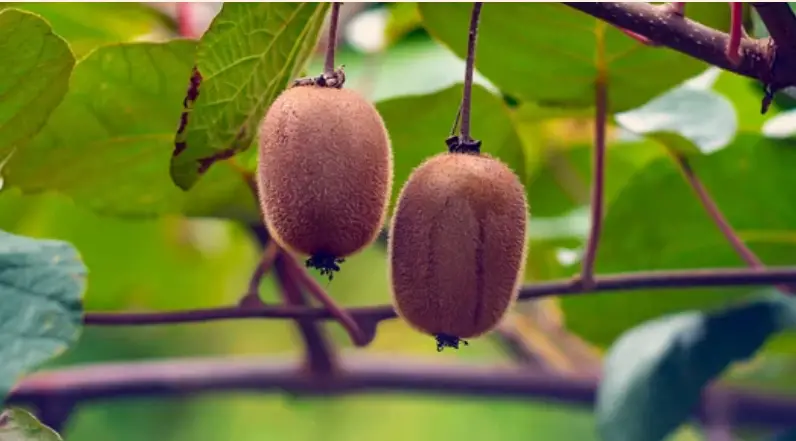The delicious, fuzzy kiwi fruit is well-known for its sweet-tart flavor and brilliant green flesh.
Kiwis are a popular fruit that many people appreciate as a tasty addition to their diets, but few may be aware that these small fruits also need particular environmental conditions to grow.
For successful cultivation, whether you’re a home gardener or a professional farmer, you must know where kiwis can thrive.
Discover the various areas where kiwis can thrive as well as some optimal growing circumstances.
Climatic Requirements

Kiwis, scientifically known as Actinidia deliciosa, are native to China, and their successful growth depends largely on the climate.
These fruits prefer temperate and subtropical climates.
They need a minimum of 140 frost-free days during the growing season, which typically spans from early spring to late autumn.
For kiwis to flourish, they need a climate with a well-defined winter period.
This dormant phase is crucial for their overall health and fruiting.
Warm, mild summers with average temperatures around 75-85°F (24-30°C) are ideal for kiwi plants.
They also thrive in regions with adequate rainfall, around 40-50 inches (100-125 cm) annually, to support their growth and fruit production.
Sunlight and Soil
Kiwis are sun-loving plants. They require plenty of direct sunlight to grow and produce fruit.
A minimum of six hours of full sunlight per day is essential for optimal development.
Inadequate sunlight can lead to poor fruit production and overall plant health.
Regarding soil, kiwi plants are not particularly fussy but prefer well-draining, loamy soil that is slightly acidic, with a pH between 6.0 and 7.0.
It’s essential to ensure proper drainage to prevent waterlogged roots, which can lead to root rot.
Kiwis also thrive in fertile soil with ample organic matter, which helps retain moisture and provides essential nutrients.
Where Can Kiwis Grow?

With significant kiwi-producing locales worldwide, kiwi production is widely distributed geographically. Here are some crucial regions where kiwis can thrive:
1. New Zealand:
New Zealand is renowned for its high-quality kiwi production. The country’s temperate climate, with mild winters and warm summers, is perfect for growing kiwis. The Kiwifruit Act established New Zealand as a major player in the global kiwi market, making it the largest kiwi exporter.
2. Italy:
Italy is another prominent kiwi producer, mainly in the northern regions. The country’s climatic conditions are suitable for kiwi cultivation, and Italy is known for its unique kiwi variety, the Hayward, which is widely popular.
3. United States:
In the United States, kiwi cultivation primarily takes place in California, where the climate is Mediterranean, and in parts of the Pacific Northwest. California’s climate and fertile soil provide excellent conditions for kiwi farming.
4. China:
Kiwis originated in China, and the country remains one of the world’s largest kiwi producers. Regions like Sichuan, Shaanxi, and Henan are known for their kiwi orchards.
5. Other Countries:
Kiwi cultivation can also be found in various other countries, including Chile, France, Spain, and Greece, among others. These regions offer suitable climates and conditions for growing kiwis.
Challenges in Kiwi Cultivation
While kiwis can grow in diverse regions, there are some challenges associated with their cultivation.
One major concern is the risk of frost during the winter months, which can damage the plants and reduce fruit yields.
To mitigate this risk, growers often employ frost protection measures, such as wind machines, overhead sprinklers, or frost blankets.
Another challenge is the need for proper pruning and trellising to manage the vines, which can grow quite vigorously.
Pruning is essential for maintaining plant health, promoting fruit production, and making harvesting more manageable.
Harvesting and Storage
Harvesting kiwis at the right time is crucial for ensuring the best flavor and texture.
Kiwis are typically ready for picking in late autumn, but the exact timing may vary depending on the local climate.
They should be picked when slightly firm but not too hard, and still slightly tangy.
After harvesting, kiwis can be stored in a cool, humid environment for several months, allowing them to ripen gradually.
Conclusion
Kiwis are adaptable fruits that may grow in a variety of environments around the world as long as they are given the ideal climatic conditions, enough sunlight, well-draining soil, and proper maintenance.
Kiwi-growing regions and accompanying difficulties should be understood by both home and commercial producers in order to successfully develop these delectable fruits.
Kiwi cultivation can be a rewarding and profitable endeavor whether you’re in New Zealand, Italy, the United States, or any other suitable region.
Kiwis produced in your own garden can be enjoyed for their delicious flavor with the correct conditions, soil, and care.
If you give the correct conditions for their growth, these adaptable fruits have been prized for generations and will continue to be a delicious addition to your culinary explorations.
So why not start your own kiwi farm and enjoy the fruits of your labor in every tart and sweet bite?




